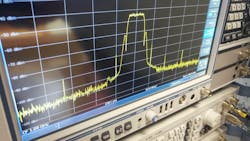Testing for Transient EMI with Real-Time Spectrum Analysis (Download)
If you’ve ever tried to perform electromagnetic-interference (EMI) testing for compliance on intermittent or rapidly varying frequency or amplitude signals, you know that this effort is very difficult. Traditional swept or scanned spectrum-analysis methods will not respond fast enough to reliably capture these kinds of EMI events.
Enter real-time spectrum analysis (RTSA), which has a decided advantage over those scanned or swept spectrum-analysis methods to troubleshoot EMI.
EMI consists of an interfering source, a coupling path, and a susceptible device. Failures may occur in a susceptible device in the form of equipment damage, degraded performance, and/or functional failures.
